10+ Leadership Development Goals Examples to Download
Setting goals before devising an action plan is an essential part of the plan-making process. If you know what you are aiming for, it will guide you in deciding what activities to carry out in ensuring the success of your game plan. This rule applies to several situations, including constructing a professional development plan for your leadership skills. That said, before jumping off to start your leadership training, you should first equip yourself by composing your leadership development goals.
10+ Leadership Development Goals Examples
1. Personal Leadership Development Goals
2. Longterm Leadership Development Goals
3. Executive Leadership Development Goals
4. Smart Leadership Development Goals
5. Team Leadership Development Goals
6. Leadership Development and Management Goals
7. Leadership Professional Development Goals
8. Career Leadership Development Goals
9. Leadership Self Development Goals
10. Leadership Development Program Goals
11. Leadership Development Training Goals
What Is a Leadership Development Goal?
Leadership development goals are the objectives that leaders aim to achieve by the end of their plan or training. It comprises of hard skills and soft skills that organization leaders should attain to thrive in their careers. The skills on the list should help raise the efficacy of a leader in managing a group of people belonging to an organization.
How to Set Workable Leadership Development Goals
Most organizations, especially the ones that involve numerous staff, need leaders. They need someone who will hold the responsibility of guiding their members. That said, they need to aim to better their skills constantly, particularly the skills aligned to shepherding professional employees. Leadership goal setting is a process that requires a lot of brainstorming. Your list of goals will serve as your anchor in your development plan, so you need to ensure that they are practical and rational.
1. Conduct a Personal SWOT Analysis
The first step in the process of goal setting is to conduct a self evaluation. To do this, you can implement a personal SWOT analysis. After performing this analysis, you will learn your strengths, weaknesses, opportunities, and possible threats. In addition, it will help you discover the soft and hard skills you need to enhance and develop to maintain sustainability.
2. Perform a Survey
After reflecting personally, it is advisable to consider the opinions of the members, specifically the ones with the first-hand experience of working with you. You can do it by handing out evaluation surveys or by arranging an interview with your selected people. This method is essential because it will inform you of the things you do not know about yourself.
3. Construct a Checklist
Now that you have the data that you need, you can start devising a checklist. Categorize your training checklist based on the skills you need to improve and those you need to obtain. Your leadership checklist will guide you on what things you need to spend your effort on and put your focus.
4. Incorporate the SMART Framework
To ensure you acquire sustainable development, you should filter the list by following the SMART goal setting. That said, in every item, you should ask yourself if that particular goal is specific, measurable, and attainable. In addition, it should also be relevant and time-based. This method will support you in establishing workable leadership goals.
FAQs
What is a leadership development plan?
A leadership development plan is a detailed framework that details the steps and activities you are willing to employ to achieve your leadership goals. The activities in this plan include games and exercises that will further practice your management skills. In planning to be a better leader, you should also consider including going through executive coaching in your plan.
What are examples of leadership styles?
You can differentiate leadership styles by categorizing them based on how a leader interacts with the members. Like how people have different beliefs and characteristics, they also implement different kinds of leadership. These approaches include autocratic leadership, free-rein leadership, democratic leadership, and paternalistic leadership. Each of them has corresponding advantages and disadvantages.
What are the qualities of successful leaders?
A good leader is someone who can create a strong rapport with his or her members. The figurehead should be knowledgeable in giving advice and should practice empathizing with the employees. They should also be self-aware. That said, they should know how to take accountability for their actions. Lastly, a leader should have a considerable influence on the members of the group or organization.
Organizations, such as schools and business companies, constantly encourage the people under them to grow. That said, as an assigned leader, you must serve as the role model and spearhead this development. The pace of an individual’s growth is unique from each other. That said, get a head start by setting your leadership development goals now.
10+ Leadership Development Goals Examples to Download

Setting goals before devising an action plan is an essential part of the plan-making process. If you know what you are aiming for, it will guide you in deciding what activities to carry out in ensuring the success of your game plan. This rule applies to several situations, including constructing a professional development plan for your leadership skills. That said, before jumping off to start your leadership training, you should first equip yourself by composing your leadership development goals.
10+ Leadership Development Goals Examples
1. Personal Leadership Development Goals
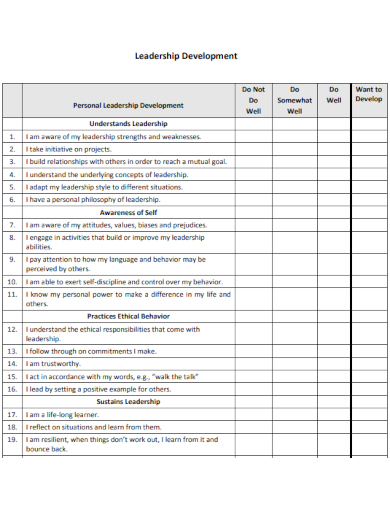
cdn.ymaws.com
Details
File Format
PDF
Size: 4 MB
2. Longterm Leadership Development Goals
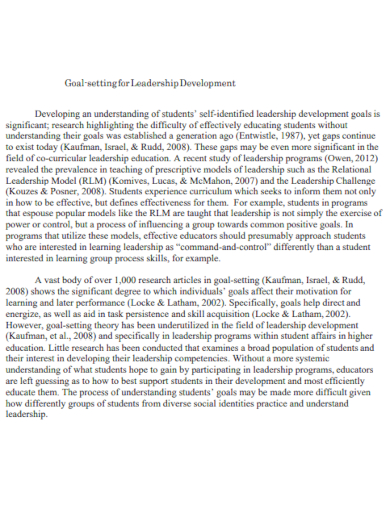
journalofleadershiped.org
Details
File Format
PDF
Size: 342 KB
3. Executive Leadership Development Goals
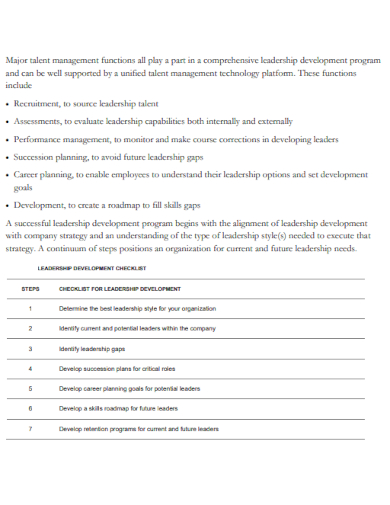
oracle.com
Details
File Format
PDF
Size: 513 KB
4. Smart Leadership Development Goals

ucdenver.edu
Details
File Format
PDF
Size: 384 KB
5. Team Leadership Development Goals
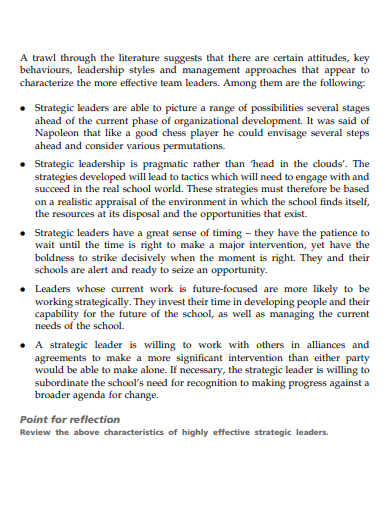
us.sagepub.com
Details
File Format
PDF
Size: 140 KB
6. Leadership Development and Management Goals
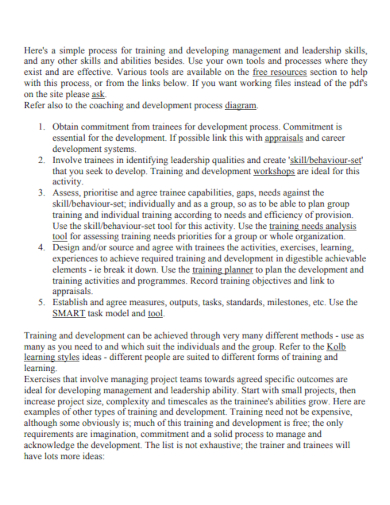
trainingcourses.org
Details
File Format
PDF
Size: 152 KB
7. Leadership Professional Development Goals
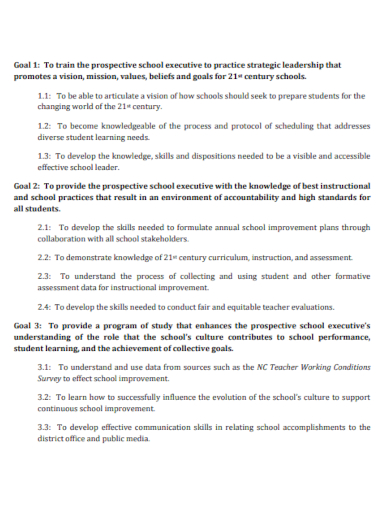
highpoint.edu
Details
File Format
PDF
Size: 452 KB
8. Career Leadership Development Goals

explorevr.org
Details
File Format
PDF
Size: 146 KB
9. Leadership Self Development Goals
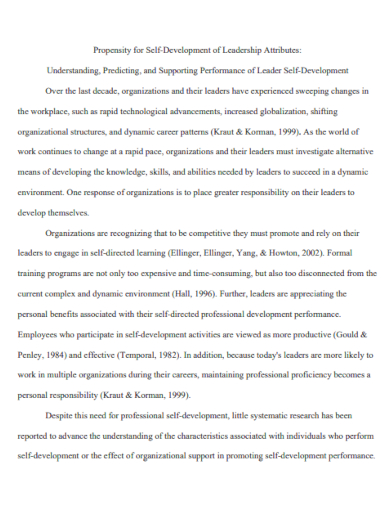
media.ccl.org
Details
File Format
PDF
Size: 77 KB
10. Leadership Development Program Goals

epiphanycoaches.com
Details
File Format
PDF
Size: 713 KB
11. Leadership Development Training Goals
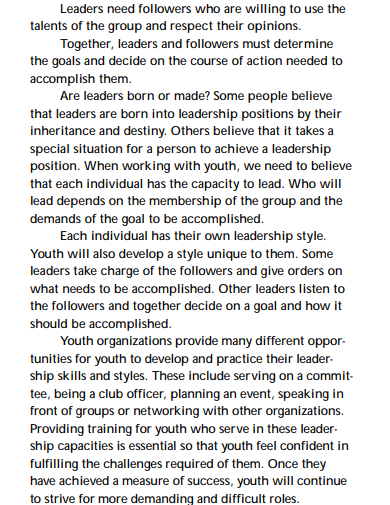
uaex.edu
Details
File Format
PDF
Size: 25 KB
What Is a Leadership Development Goal?
Leadership development goals are the objectives that leaders aim to achieve by the end of their plan or training. It comprises of hard skills and soft skills that organization leaders should attain to thrive in their careers. The skills on the list should help raise the efficacy of a leader in managing a group of people belonging to an organization.
How to Set Workable Leadership Development Goals
Most organizations, especially the ones that involve numerous staff, need leaders. They need someone who will hold the responsibility of guiding their members. That said, they need to aim to better their skills constantly, particularly the skills aligned to shepherding professional employees. Leadership goal setting is a process that requires a lot of brainstorming. Your list of goals will serve as your anchor in your development plan, so you need to ensure that they are practical and rational.
1. Conduct a Personal SWOT Analysis
The first step in the process of goal setting is to conduct a self evaluation. To do this, you can implement a personal SWOT analysis. After performing this analysis, you will learn your strengths, weaknesses, opportunities, and possible threats. In addition, it will help you discover the soft and hard skills you need to enhance and develop to maintain sustainability.
2. Perform a Survey
After reflecting personally, it is advisable to consider the opinions of the members, specifically the ones with the first-hand experience of working with you. You can do it by handing out evaluation surveys or by arranging an interview with your selected people. This method is essential because it will inform you of the things you do not know about yourself.
3. Construct a Checklist
Now that you have the data that you need, you can start devising a checklist. Categorize your training checklist based on the skills you need to improve and those you need to obtain. Your leadership checklist will guide you on what things you need to spend your effort on and put your focus.
4. Incorporate the SMART Framework
To ensure you acquire sustainable development, you should filter the list by following the SMART goal setting. That said, in every item, you should ask yourself if that particular goal is specific, measurable, and attainable. In addition, it should also be relevant and time-based. This method will support you in establishing workable leadership goals.
FAQs
What is a leadership development plan?
A leadership development plan is a detailed framework that details the steps and activities you are willing to employ to achieve your leadership goals. The activities in this plan include games and exercises that will further practice your management skills. In planning to be a better leader, you should also consider including going through executive coaching in your plan.
What are examples of leadership styles?
You can differentiate leadership styles by categorizing them based on how a leader interacts with the members. Like how people have different beliefs and characteristics, they also implement different kinds of leadership. These approaches include autocratic leadership, free-rein leadership, democratic leadership, and paternalistic leadership. Each of them has corresponding advantages and disadvantages.
What are the qualities of successful leaders?
A good leader is someone who can create a strong rapport with his or her members. The figurehead should be knowledgeable in giving advice and should practice empathizing with the employees. They should also be self-aware. That said, they should know how to take accountability for their actions. Lastly, a leader should have a considerable influence on the members of the group or organization.
Organizations, such as schools and business companies, constantly encourage the people under them to grow. That said, as an assigned leader, you must serve as the role model and spearhead this development. The pace of an individual’s growth is unique from each other. That said, get a head start by setting your leadership development goals now.

